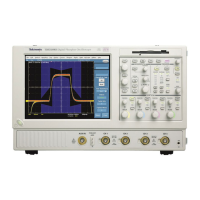47
Creating Your Own Control Windows
—new ways to make your job easier
For quick access to the controls that you use most often, you can create your own MyScope
control window. Choose from a list of controls to include and make each control window unique
to your needs. MyScope allows you to have up to eight tabs in a control window, increasing the
flexibility and ease of use for your unique MyScope control windows. You can create and save
any number of controls windows for future use.
Triggering, Timebase, and Horizontal Delay
—a comparison with oscilloscopes of the past
The architecture of an analog oscilloscope requires its time bases and triggering to be linked. The
main trigger triggers the main time base, and then you can use a delayed trigger to trigger a
delayed time base. Many digital oscilloscopes have also been designed using this traditional but
complex paradigm.
This instrument uses a simpler paradigm that cleanly separates the concepts of triggering and time
bases. You can still do everything that you could with an analog oscilloscope and more. Now
these features are easier to set up and use.
The trigger event can be simple or complex. Examples of a simple trigger are the rising edge of
Channel 1 or a glitch narrower than 10 ns on Channel 2. You can set up a complex trigger where
the trigger system is armed by a condition on one channel and then is triggered by a condition on
another channel. In either case, simple or complex, there is just one trigger event.
The time base can be either delayed or not delayed. If it is not delayed, acquisition occurs
surrounding the trigger event depending on the amount of pretrigger and posttrigger data that you
have selected. If you turn on horizontal delay, you can delay the acquisition to a point well beyond
the trigger event (similar in effect to a delayed time base). By alternately turning horizontal delay
on and off, you can make quick, detailed comparisons between two segments of a signal that are
separated from each other by a fixed amount of time. In any case, the time base is always triggered
by one trigger event.
Looking at Waveform Details
—taking advantage of the full resolution of the instrument
Use the instrument MultiView Zoom function to magnify an acquisition vertically, horizontally, or
in both dimensions to let you see the fine detail in your signals. The MultiView Zoom function
affects only the display, not the actual waveform that is being acquired.
The fastest way to set up a Zoom display is to click (or touch) and drag across the segment of the
waveform that you want to see in greater detail. Then, when you touch or click the on-screen
Zoom menu item, that waveform appears in the Zoom (lower) graticule, while the entire waveform
appears in the Acquisition (upper) graticule. Markers in the main graticule give you position
context for what you are seeing in the Zoom graticule.
Another way to set up the MultiView Zoom function is to push the front-panel MultiZoom button.
Then you can set parameters in a control window to focus your Zoom waveform on the signal
segment of interest.
To see more waveform detail you can also use horizontal delay (as described in the previous topic)
to focus the acquisition on a segment of a waveform separated from the trigger event by a

